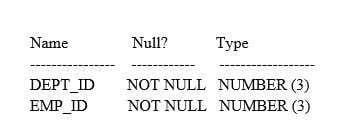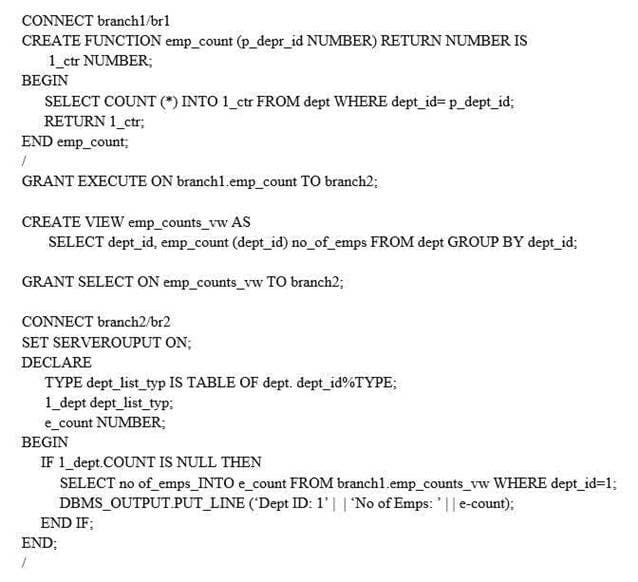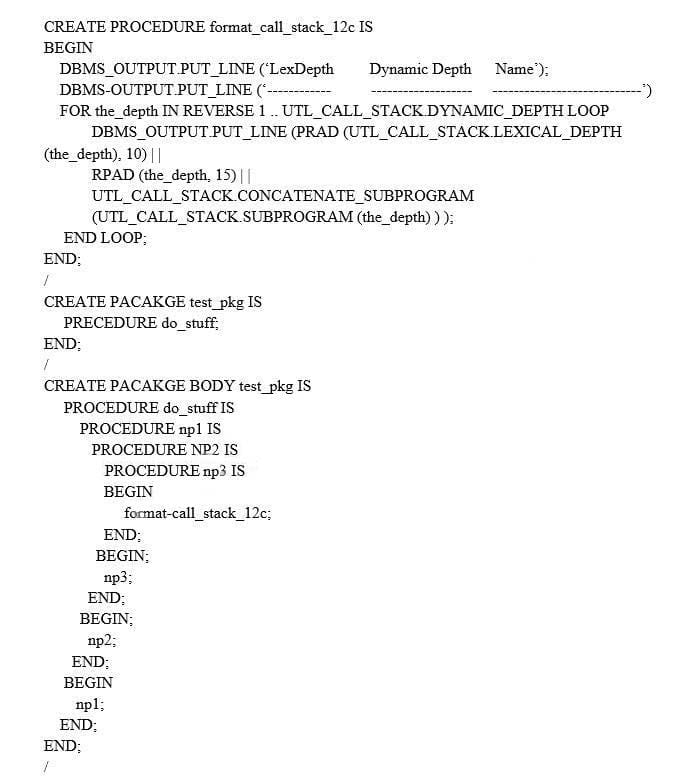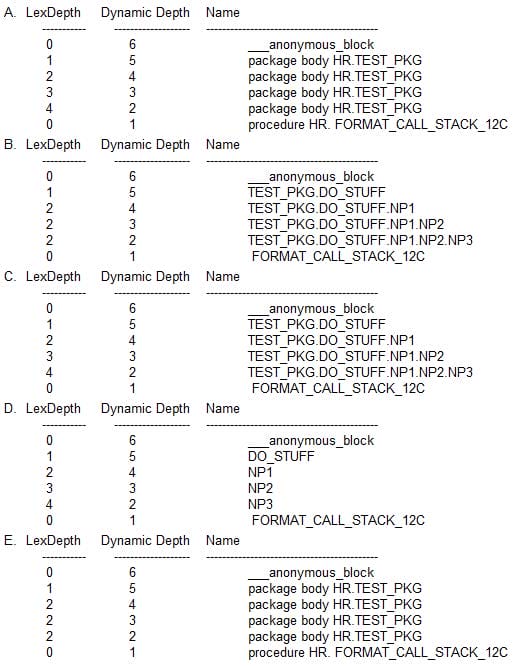Exam Details
Exam Code
:1Z0-148Exam Name
:Oracle Database: Advanced PL/SQLCertification
:Oracle CertificationsVendor
:OracleTotal Questions
:243 Q&AsLast Updated
:Mar 26, 2025
Oracle Oracle Certifications 1Z0-148 Questions & Answers
-
Question 31:
Examine the structure of the DEPT table which exists in both BRANCH1 and BRANCH2 schemas:

Examine this code:

Which three modifications must be done to endure the anonymous block displays the output form the BRANCH2.DEF DEPT table?
A. Change the IF condition in the anonymous block to 1_dept IS EMPTY.
B. Change the IF condition in the anonymous block to CARDINALITY (1_dept) IS NULL.
C. Add BEQUEATH DEFINER to the EMP_COUNT_VW view.
D. Add BEQUEATH CURRENT_USER to the EMP_COUNTS_VW view.
E. IN BRANCH2 execute GRANT INHERIT PRIVILEGES ON USER branch2 TO branch1;
F. Add AUTHID CURRENT_USER to the EMP_COUNT function.
-
Question 32:
Which three statements are true about varrays in a database table column? (Choose three.)
A. A varray used as a column in a database table must be initialized to empty.
B. A varray may be stored outside the table segment in which it is defined but still in the same tablespace.
C. A varray's size can be increased beyond the maximum number of elements specified in the definition.
D. A varray is always stored in the same segment as the table in which it is defined.
E. The data in a single element of a varray can be changed through either PL/SQL or SQL.
F. The data in a single element of a varray can only be changed through PL/SQL.
G. A varray's size can be both increased and decreased from the maximum number of elements specified in the definition.
H. A varray used as a column in a database table must be initialized to null.
-
Question 33:
Which two statements will raise an exception? (Choose two.)
A. SELECT DBMS_ASSERT.SIMPLE_SQL_NAME ('"10_Employees"') FROM dual;
B. SELECT DBMS_ASSERT.SIMPLE_SQL_NAME ('Employees@my_dblink') FROM dual;
C. SELECT DBMS_ASSERT.SIMPLE_SQL_NAME (' Emp_Dept_information_table ') FROM dual;
D. SELECT DBMS_ASSERT.SIMPLE_SQL_NAME ('Employee_Department_information_table') FROM dual;
E. SELECT DBMS_ASSERT.SIMPLE_SQL_NAME ('Employees@') FROM dual;
-
Question 34:
Examine this code:
CREATE TYPE list_typ IS TABLE OF NUMBER;
/
DECLARE
l_list list_typ := list_typ ();
Which two executable sections will display the message TRUE?
A. BEGIN IF l_list.LIMIT IS NOT NULL THEN DBMS_OUTPUT.PUT_LINE (‘TRUE’); END IF; END;
B. BEGIN l_list.EXTEND; IF l_list.PRIOR (1_list.FIRST) IS NULL THEN DBMS_OUTPUT.PUT_LINE (‘TRUE’); END IF; END;
C. BEGIN l_list.EXTEND; IF l_list IS EMPTY THEN DBMS_OUTPUT.PUT_LINE (‘TRUE’); END IF; END;
D. BEGIN IF l_list.FIRST IS NULL THEN DBMS_OUTPUT.PUT_LINE (‘TRUE’); END IF; END;
E. BEGIN IF l_list.FIRST =1 THEN DBMS_OUTPUT.PUT_LINE (‘TRUE’); END IF; END;
-
Question 35:
Examine this code (all compiled into schema HR): Execute this code:

SET SERVEROUTPUT ON;
EXEC test_pkg.do_stuff What is the correct output?

A. Option A
B. Option B
C. Option C
D. Option D
E. Option E
-
Question 36:
You are designing and developing a complex database application and implementing fine-grained access control using security policies.
Which statement is true with respect to attaching security policies to database objects?
A. You can use different security policies for SELECT, INSERT, UPDATE, INDEX and DELETE statements.
B. You can use only one security policy per database object.
C. You implement security policies through database procedures.
D. Column-masking policies can be applied to SELECT, INSERT, UPDATE and DELETE statements.
-
Question 37:
Examine this query executed as SYS and its output:

Which two observations are true based on the output?
A. The client-side result cache and the server-side result cache are enabled.
B. All distinct query results are cached for the duration of a SYS user session.
C. Repetitive SQL queries and PL/SQL function results are cached and automatically used from the cache across all SYS user sessions.
D. The result cache exists but which SQL queries are cached depends on the value of the RESULT_CACHE_MODE parameter.
E. Repetitive SQL queries executed on permanent non-dictionary objects may have faster response times.
-
Question 38:
Which two statements about the PL/SQL hierarchical profiler are true?
A. Access it using the DBMS_PROFILER package.
B. Access it using the DBMS_HPROF package.
C. Profiler data is recorded in tables and published in HTML reports.
D. It is only accessible after a grant of the CREATE PROFILE privilege.
E. It helps you identify subprograms that are causing bottlenecks in application performance.
-
Question 39:
Which two statements are true with respect to fine-grained access control?
A. It is implemented by end users.
B. It can be used to implement column masking.
C. It implements security rules through functions and associates these security rules with tables, views or synonyms.
D. Separate policies are required for queries versus INSERT/UPDATE/DELETE statements.
E. The DBMS_FGA package is used to set up fine-grained access control.
-
Question 40:
Examine this function header: FUNCTION calc_new_sal (emp_id NUMBER) RETURN NUMBER;
You want to ensure that whenever this PL/SQL function is invoked with the same parameter value across active sessions, the result is not recomputed.
If a DML statement is modifying a table which this function depends upon, the function result must be recomputed at that point in time for all sessions calling this function.
Which two actions should you perform?
A. Ensure RESULT_CACHE_MAX_SIZE is greater than 0.
B. Enable the result cache by using DBMS_RESULT_CACHE.BYPASS (FALSE).
C. Add the deterministic clause to the function definition.
D. Add the RELIES_ON clause to the function definition.
E. Add the RESULT_CACHE clause to the function definition.
Related Exams:
1Z0-020
Oracle8i: New Features for Administrators1Z0-023
Architecture and Administration1Z0-024
Performance Tuning1Z0-025
Backup and Recovery1Z0-026
Network Administration1Z0-034
Upgrade Oracle9i/10g OCA to Oracle Database OCP1Z0-036
Managing Oracle9i on Linux1Z0-041
Oracle Database 10g: DBA Assessment1Z0-052
Oracle Database 11g: Administration Workshop I1Z0-053
Oracle Database 11g: Administration II
Tips on How to Prepare for the Exams
Nowadays, the certification exams become more and more important and required by more and more enterprises when applying for a job. But how to prepare for the exam effectively? How to prepare for the exam in a short time with less efforts? How to get a ideal result and how to find the most reliable resources? Here on Vcedump.com, you will find all the answers. Vcedump.com provide not only Oracle exam questions, answers and explanations but also complete assistance on your exam preparation and certification application. If you are confused on your 1Z0-148 exam preparations and Oracle certification application, do not hesitate to visit our Vcedump.com to find your solutions here.